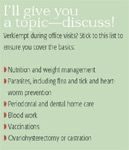Client education: Who's responsible?
Are you informal about informing, easygoing about educating, casual about coaching clients about their animals? See how more structure benefits your practice, pet owners, and patients.
Caitlin Rivers
"The best way to effectively educate clients is to interact with them, to reach out and touch them—not through brochures, not through letters, but through discussion. You are your practice's most important educational tool."

Caitlin Rivers
Doctors spend an average of 12.3 minutes with clients during a wellness visit, according to the 2007 Veterinary Economics Business Issues Study. And the 2006 Veterinary Economics Business Issues Study shows that 45 percent of practices reported team members dedicate an average of 11 to 20 minutes to the wellness exam (see Figure 1).

That gives you a great deal of power, because clients make decisions about the care they'll provide for their pets based on what you know and how you present the information.

Figure 1
Because repetition breeds compliance, all doctors and team members should know basic information on all topics, so practices send clients a unified message with the same recommendations, says Mandy Stevenson, RVT, a Firstline Editorial Advisory Board member and a technician in Creighton, Mo.
The learning curve
So how do team members evolve into fonts of knowledge? "We teach them," says Stevenson. Doctors and team members get crash courses on all topics through in-house seminars and manufacturer presentations. To teach the nitty gritty details and turn novices into experts, Caitlin Rivers, a veterinary assistant and technician supervisor at Metzger Animal Hospital in State College, Pa., recommends a combination of on-the-job exposure, discussions, and homework. She uses quiz games, articles, and job shadowing to train technicians at her hospital. In fact, Rivers, a Firstline board member, says team members learn most effectively when they participate in clients' visits and have the opportunity to observe and ask questions.
Besides absorbing the hard facts, it's important to train your team members to read clients for the questions they want you to answer and how they want to receive it. And team members must feel comfortable discussing the topics and believe in the importance of the recommendations they're making, Rivers says.

I'll give you a topic-discuss!
"Clients can tell when team members are selling them a product or service and when they're recommending something for the good of their pet," she says. "When clients see that team members believe in their recommendations, they're more likely to comply, and that's when sales go up." (See "Does Selling Your Services Mean Selling Out?")
Knowledge is power
"Establishing a client education protocol is the best way to expose all clients to all wellness topics at all stages of life," says Stevenson. "When you educate clients, you spend more time preventing and less time curing." Stevenson also says that sometimes, team members at practices without a client education plan make assumptions about clients' ability to pay and their interest in doctors' and team members' recommendations. Then they use those assumptions to determine whether they share all the patient's options. Developing a protocol gives you a positive, effective way to approach all clients with your advice, which empowers clients to provide high-quality care.
Now more than ever, clients are looking to doctors and team members for wellness information and craving their recommendations. By providing these services, you can ensure your patients receive access to the care they need.